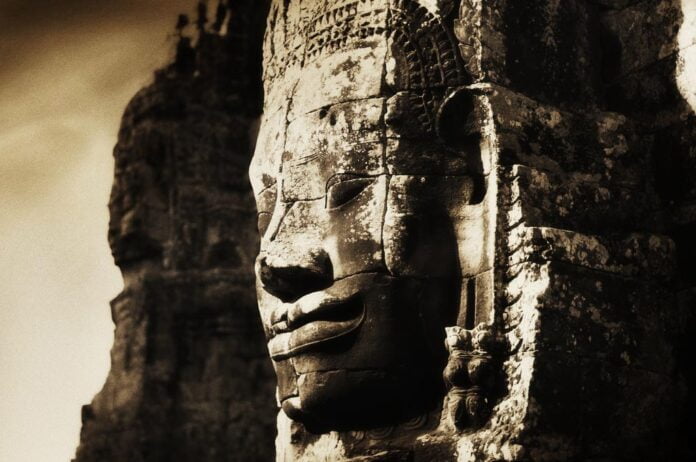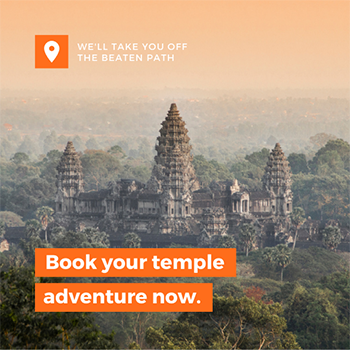Beautiful desert-island beaches, jungle trekking in protected reserves, café-culture in a capital city full of complex history– and, of course, 1000-year old temples from one of the most impressive empires in world history: Cambodia certainly is the Kingdom of Wonder.
Cambodia has blossomed into one of the key Asian destinations for luxury holiday-makers, backpackers and everyone in between. Nestled in between Thailand, Vietnam and Laos, this “watery Kingdom”, as it was first described during the inception of the Khmer empire thousands of years ago, is well-connected on transport routes, has a wealth of attractions and is particularly easy to travel due to the relatively high level of English spoken in comparison to neighboring countries.
Defined by history
Cambodia is well-known for two things – the temples of Angkor and the Khmer Rouge. The former are an enormous source of pride within Cambodian culture. The ancient Khmer Empire (9th – 15th centuries AD) covered much of modern day Thailand and Vietnam and is seen as the glory-days of Cambodia, and the birthplace of many of the cultures, languages and traditions of the entire region. Any visit to Cambodia is incomplete without a trip to Angkor Wat to gain an insight into the hugely important role this empire played in the history of the area, as well as in contemporary Cambodian society.
Conversely, the tragedy of the Khmer Rouge and the ensuing civil war are not frequently spoken about in modern day Cambodia – the trauma still in living memory for much of the population. Between 1975 and 1979 around 2 million people were killed from overwork, starvation, disease or execution. The entire infrastructure of the country (schools, healthcare, currency) was either destroyed or massively compromised. As per Pol Pot’s intention, the country was brought back to “year zero”.
Cambodia’s future
The future of Cambodia is looking brighter than ever before! The country has made impressive strides in recent years, thanks in part to its youthful population. With around half of its 14 million residents under 30, there’s a contagious energy of innovation and progress in the air, especially in the vibrant capital of Phnom Penh.
In fact, tourism has been booming, with a record-breaking 6.6 million visitors in 2019 before the pandemic hit. While the industry took a hit, Cambodia is already bouncing back and is predicted to see a steady increase in visitors in the coming years.
And there’s plenty for visitors to enjoy, with a wealth of new restaurants, hotels, and activities popping up all over the country. From stunning beaches and lush jungles to ancient temples and bustling markets, Cambodia truly has something for everyone.
Just remember, the best time to visit is between November and February, when the weather is cool and comfortable. But even in the rainy months between June and September, there’s still plenty to see and do. Don’t miss out on this incredible destination!
Phnom Penh and the Provinces
Cambodia’s capital city – Phnom Penh (pronounced Puh-nom Penyh), although relatively small as capital cities go, is certainly bustling! With busy streets packed with motorbikes, street vendors, and tourists it can be overwhelming at first. However, there is a charm to Phnom Penh. Head to the Olympic Stadium at around 4pm to see scores of people doing open air aerobics or take a sunset boat cruise on the river where the Tonle Sap meets the Mekong. Phnom Penh’s growing café culture is also perfect for people watching and soaking in the atmosphere of the city.
Outside Phnom Penh, Cambodia has a further 22 provinces. These are dominated by two huge waterways – the Tonle Sap on the east (flowing from and into the Tonle Sap Lake) and the mighty Mekong to the west. As a result, Cambodia has an ideal ecosystem for rice farming, and the majority of the provinces are dominated by agriculture and carpeted with rice fields. However, heading east visitors find rolling hills and swathes of jungle. There’s a chance to spot river dolphins on the Mekong in Kratie or spend time chilling out and eating delicious crab in the beach towns of Kep and Sihanoukville.
“Nyam bai?”
Nyam bai – literal translation “eat rice” is how to ask in Khmer whether you have eaten yet. You do not eat in Cambodia without eating rice. Not only is rice Cambodia’s main form of industry (80% of the population are rural rice farmers) rice also dominates the food culture. Sitting down to eat rice (nyam bai) as a family is hugely important and no meal is complete without a bowl of rice. Traditional Khmer cuisine involves a big bowl of rice with a few shared dishes – usually including a soup and some kind of stir-friend meat and vegetables. Famous Khmer dishes include Amok curry (a light, coconut curry flavored with the Amok herb) and Loc Lac (beef in a peppery sauce with an egg on top) but more every day fare is fried rice or fried noodles with meat and vegetables. It is considered polite to always offer to share your food to someone if you are eating. If you are hungry, it is fine to accept, but also a polite decline explaining that you have already eaten is not considered rude.
Khmer language
Khmer is the language of Cambodia. It’s not a tonal language, but is notoriously complicated to learn – with 35 consonants and 23 vowels. It’s relatively easy to learn a few basic phrases however. Making the effort to say “Sursedey” (hello/good-day), “soksabye” (how are you) or “awkun” (thank you) tends to be much appreciated. and may earn you an additional discount when bargaining, or some additional help or kindness when navigating around the area.
Monarchy and Politics
Cambodia is a “Kingdom” and the regent is Norodom Sihamoni, eldest son of Norodom Sihanouk, referred to as “King-Father” by many Cambodians. The King is a highly respected figure, although now has little political power.
The Cambodian government is led by Hun Sen, one of the longest-serving prime-ministers in the world, having been in power of over 14,000 days since the fall of the Khmer Rouge. As a result, politics is a sensitive issue in Cambodia – with few people feeling confident to share their views.
Customs and traditions
Cambodia celebrates 19 public holidays honoring an array of political, religious and international festivals. Family traditions and celebrations are incredibly important, with wedding parties lasting at least 2 days and respects to elders and ancestors forming part of everyday customs as well as important yearly celebrations.
In Khmer culture, elders are respected and there are different forms of address to give respect to people of different ages. Many cultural customs are connected to Buddhism, the national religion. The head is considered sacred, and the feet unclean. The preservation of harmony in relationships is crucially important and displaying anger or excessive emotion in public is thought inappropriate. This cultural nicety is perhaps one of the reasons why Cambodia was voted the friendliest country to visit in the world as visitors are always treated with kindness, patience and smiles.



